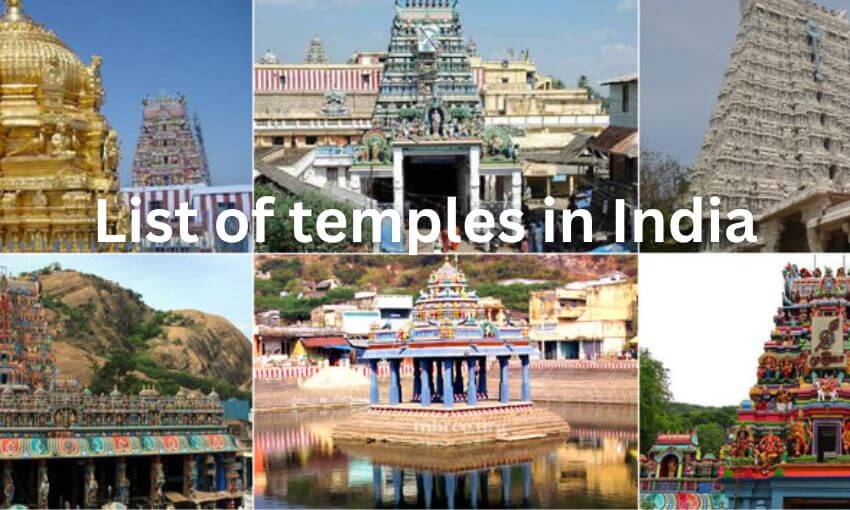India is a land of many religions and cultures, and it is home to a variety of temples. This list of temples in India is a comprehensive guide to the most famous and important temples in the country. It includes temples from all major religions, including Hinduism, Buddhism, Jainism, and Sikhism. The list also includes some of the most famous and important temples in India, such as the Golden Temple in Amritsar, the Meenakshi Temple in Madurai, and the Jagannath Temple in Puri. Each temple has its own unique history and significance, and this list provides a brief overview of each temple.

The History of India’s Temples: A Look at the Ancient and Modern Structures
India is home to some of the most beautiful and awe-inspiring temples in the world. From the ancient and majestic structures of the past to the modern and innovative designs of today, India’s temples have a long and fascinating history.
The earliest temples in India date back to the Indus Valley Civilization, which flourished between 2600 and 1900 BCE. These temples were made of mud brick and were often decorated with intricate carvings and sculptures. The most famous of these ancient temples is the Great Bath of Mohenjo-Daro, which is believed to have been used for religious ceremonies.
As time passed, the design of Indian temples evolved. During the Gupta period (320-550 CE), temples began to be built in stone, and the architecture became more elaborate. The most famous example of this period is the Kailasa Temple at Ellora, which is a massive rock-cut temple complex.
In the medieval period, temples became even more ornate and elaborate. The most famous example of this period is the Brihadeeswarar Temple in Thanjavur, which was built in the 11th century. This temple is an example of the Dravidian style of architecture, which is characterized by its tall towers and intricate carvings.
In the modern era, Indian temples have become even more innovative and creative. Many of the modern temples are built in a fusion of traditional and modern styles, and they often feature modern amenities such as air conditioning and elevators. The most famous example of this is the Akshardham Temple in Delhi, which was built in 2005 and is one of the largest Hindu temples in the world.
India’s temples are a testament to the country’s rich and diverse history. From the ancient structures of the past to the modern and innovative designs of today, India’s temples are a source of beauty and inspiration.
The Preservation of India’s Temples: A Look at the Challenges and Solutions
India is home to some of the most beautiful and ancient temples in the world. These temples are a source of pride and joy for many Indians, and they are a symbol of the country’s rich cultural heritage. Unfortunately, many of these temples are in danger of being lost due to a variety of factors, including natural disasters, vandalism, and neglect. In order to preserve these temples for future generations, it is important to understand the challenges they face and the solutions that can be implemented to protect them.
One of the biggest challenges facing India’s temples is the threat of natural disasters. Earthquakes, floods, and other natural disasters can cause significant damage to these ancient structures, and they can be difficult to repair. In addition, many of these temples are located in remote areas, making them difficult to access in the event of an emergency. To address this issue, it is important to ensure that these temples are properly maintained and monitored for signs of structural damage. Additionally, it is important to have emergency plans in place in the event of a natural disaster.
Another challenge facing India’s temples is vandalism. Unfortunately, some people view these ancient structures as easy targets for vandalism and theft. To address this issue, it is important to ensure that these temples are properly guarded and monitored. Additionally, it is important to educate the public about the importance of preserving these temples and the consequences of vandalizing them.
Finally, neglect is another major challenge facing India’s temples. Many of these temples are in need of repair and maintenance, but they are often overlooked due to a lack of resources or interest. To address this issue, it is important to ensure that these temples are properly maintained and monitored. Additionally, it is important to raise awareness about the importance of preserving these temples and to encourage people to donate money or time to help with their upkeep.
Preserving India’s temples is an important task that requires a concerted effort from all stakeholders. By understanding the challenges they face and implementing solutions to address them, we can ensure that these ancient structures are preserved for future generations to enjoy.
The Architecture of India’s Temples: A Study of the Different Styles and Designs
India is home to some of the most beautiful and intricate temples in the world. From the grandeur of the Taj Mahal to the intricate carvings of the Khajuraho temples, the architecture of India’s temples is a testament to the country’s rich cultural heritage. In this article, we will explore the different styles and designs of India’s temples, and how they have evolved over time.
The earliest temples in India were built in the Indus Valley Civilization, which flourished between 2600 and 1900 BCE. These temples were made of mud brick and had a simple, rectangular shape. They were often decorated with geometric patterns and symbols of the sun, moon, and stars.
The next major period of temple building in India was the Gupta period, which lasted from 320 to 550 CE. During this period, temples were built in a variety of styles, including the Nagara style, which featured a curvilinear tower, and the Dravidian style, which featured a pyramidal tower. These temples were often decorated with intricate carvings and sculptures.
The Chola period, which lasted from 850 to 1250 CE, saw the emergence of the South Indian style of temple architecture. These temples were built in a distinctive style, with a large central tower surrounded by smaller towers. They were often decorated with intricate carvings and sculptures and were often built on a grand scale.
The Mughal period, which lasted from 1526 to 1858 CE, saw the emergence of a new style of temple architecture. These temples were built in a more ornate style, with domes, arches, and minarets. They were often decorated with intricate carvings and sculptures and were often built on a grand scale.
Finally, the British period, which lasted from 1858 to 1947 CE, saw the emergence of a new style of temple architecture. These temples were built in a more modern style, with a focus on symmetry and balance. They were often decorated with intricate carvings and sculptures and were often built on a grand scale.
India’s temples are a testament to the country’s rich cultural heritage. From the earliest mud brick temples of the Indus Valley Civilization to the ornate Mughal temples of the British period, the architecture of India’s temples has evolved over time to reflect the changing tastes and styles of the people. No matter what style of the temple you visit, you are sure to be amazed by the beauty and intricacy of India’s temples.
The Significance of India’s Temples: A Look at the Cultural and Religious Impact
India is a country with a rich and diverse culture, and its temples are a reflection of this. From the ancient temples of the Indus Valley Civilization to the modern-day temples of the Hindu faith, India’s temples have played an important role in the country’s culture and religion. In this essay, we will explore the significance of India’s temples and their impact on the country’s culture and religion.
First and foremost, India’s temples are a symbol of the country’s religious beliefs. Hinduism is the predominant religion in India, and temples are an important part of the faith. They are places of worship, where people come to offer prayers and offerings to the gods. Temples are also a place of learning, where people can learn about the Hindu faith and its teachings.
In addition to being places of worship, India’s temples are also a source of cultural pride. Many of the country’s temples are centuries old and are a testament to the country’s rich history and culture. They are also a source of inspiration for many artists, who use the temples as a source of inspiration for their work.
Finally, India’s temples are a source of economic activity. Many of the country’s temples are tourist attractions, and they generate a significant amount of revenue for the local economy. This money is used to fund various projects, such as education and healthcare, which benefit the local population.
In conclusion, India’s temples are an important part of the country’s culture and religion. They are a source of religious and cultural pride, a place of worship, and a source of economic activity. India’s temples are a testament to the country’s rich history and culture, and they will continue to play an important role in the country’s future.
Exploring the Ancient Temples of India: A Guide to the Most Sacred Sites
Exploring the ancient temples of India is a journey into the country’s rich spiritual and cultural heritage. From the majestic temples of the south to the sacred shrines of the north, India is home to some of the most awe-inspiring temples in the world. In this guide, we’ll take a look at some of the most sacred sites in India, and explore the history and significance of each one.
The Golden Temple of Amritsar is one of the most important pilgrimage sites in India. Located in the state of Punjab, the temple is a symbol of Sikhism and is visited by millions of devotees each year. The temple is made of marble and gold, and its four entrances symbolize the openness of the Sikh faith. Inside, visitors can find a sacred pool, a museum, and a library.
The Sun Temple of Konark is another important temple in India. Located in the state of Odisha, the temple was built in the 13th century to honor the Hindu god Surya. The temple is made of sandstone and is decorated with intricate carvings and sculptures. Inside, visitors can find a large statue of Surya, as well as a number of smaller shrines dedicated to other Hindu gods.
The Brihadeeswarar Temple in Tamil Nadu is one of the largest temples in India. Built-in the 11th century, the temple is dedicated to the Hindu god Shiva. The temple is made of granite and is decorated with intricate carvings and sculptures. Inside, visitors can find a large statue of Shiva, as well as a number of smaller shrines dedicated to other Hindu gods.
The Jagannath Temple in Puri is one of the most important pilgrimage sites in India. Located in the state of Odisha, the temple is dedicated to the Hindu god Jagannath. The temple is made of sandstone and is decorated with intricate carvings and sculptures. Inside, visitors can find a large statue of Jagannath, as well as a number of smaller shrines dedicated to other Hindu gods.
The Kailash Temple in Ellora is one of the most impressive temples in India. Located in the state of Maharashtra, the temple was built in the 8th century to honor the Hindu god Shiva. The temple is made of rock and is decorated with intricate carvings and sculptures. Inside, visitors can find a large statue of Shiva, as well as a number of smaller shrines dedicated to other Hindu gods.
These are just a few of the many ancient temples in India. Each one is a testament to the country’s rich spiritual and cultural heritage and a reminder of the importance of faith in India. Whether you’re looking for a spiritual journey or just a chance to explore the country’s history, these temples are sure to provide an unforgettable experience.
Conclusion
The List of temples in India is a testament to the rich cultural and religious heritage of the country. It is a reminder of the importance of preserving and protecting these sacred sites, which are a source of spiritual and cultural enrichment for the people of India. The list also serves as a reminder of the importance of respecting and honoring the beliefs and traditions of the various religions and cultures that make up India.
Content from other States:
- No items




